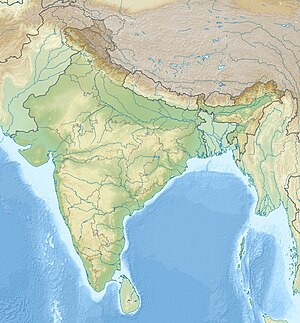| Yavanarajya inscription | |
|---|---|
Ancient Sanskrit inscription Mathura GMM 88.150 | |
| Material | red sandstone |
| Size | 102 x 37 centimeters |
| Writing | Sanskrit, Brahmi script[1] |
| Created | 1st Century BCE |
| Discovered | 1988, in Maghera, a village outside Mathura 27°34′16″N 77°35′24″E / 27.571171°N 77.590097°E |
| Place | Mathura, Uttar Pradesh |
| Present location | Mathura Museum, India |
The Yavanarajya inscription, also called the Maghera Well Stone Inscription,[2] was discovered in the village of Maghera, 17 kilometers north of Mathura, India in 1988.[3] The Sanskrit inscription, carved on a block of red sandstone, is dated to the 1st century BCE, and is currently located at the Mathura Museum in Mathura.[3][4] The inscription notes the donation of a water well and tank to the community in 1st century BCE, built by a Brahmin.[5]
The inscription was published and analysed by French indologist Gérard Fussman in 1993.[6] The inscription is in Brahmi script, and is significant because it mentions that it was made in Year 116 of the Yavanarajya ("Kingdom of the Yavanas"), and proves the existence of a "Yavana era" in ancient India.[7] It may mean that Mathura was a part of a Yavana dominion, probably Indo-Greek, at the time the inscription was created.[3]
- ^ Gerhard Lüdtke; et al. (2009). Kurschners Deutscher Gelehrten-Kalender 2009, Vols 1-4. W. de Gruyter. p. 2766.
- ^ Goyal, Shankar (2004). India's ancient past. Book Enclave. p. 183. ISBN 9788181520012.
- ^ a b c History of Early Stone Sculpture at Mathura: Ca. 150 BCE - 100 CE, Sonya Rhie Quintanilla, BRILL, 2007 pp. 254-255
- ^ "Some Newly Discovered Inscriptions from Mathura : The Meghera Well Stone Inscription of Yavanarajya Year 160 Recently a stone inscription was acquired in the Government Museum, Mathura." India's ancient past, Shankar Goyal Book Enclave, 2004, p.189
- ^ Cite error: The named reference
Rhiewas invoked but never defined (see the help page). - ^ "Ménandre l’Indo-grec ou Paul Demiéville revisité" Journal Asiatique 1993, 1-2, pages 61–138
- ^ Fussman, Gérard. The riddle of the ancient eras is not yet solved (PDF). p. 242.

